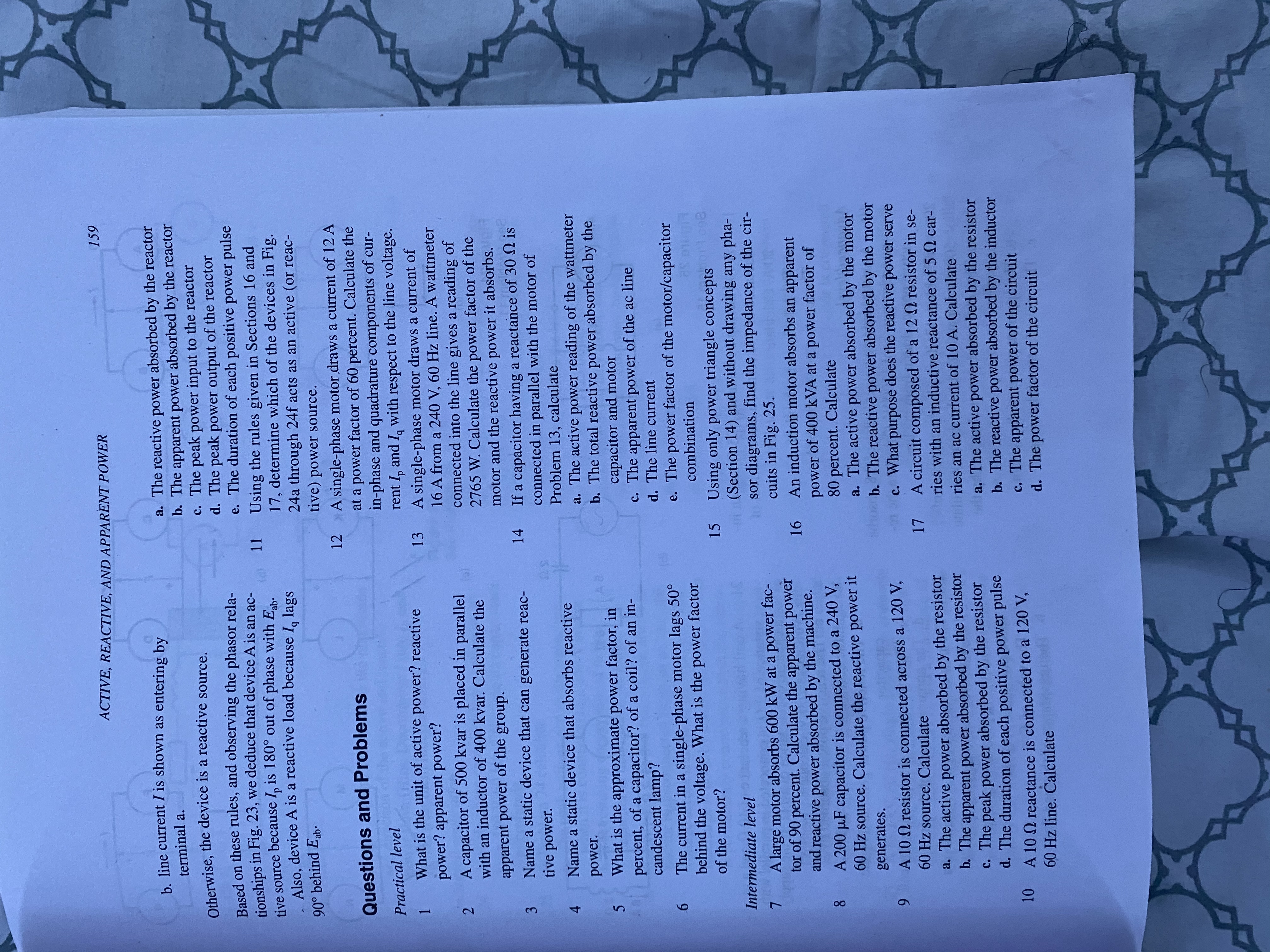
College Physics
11th Edition
ISBN: 9781305952300
Author: Raymond A. Serway, Chris Vuille
Publisher: Cengage Learning
expand_more
expand_more
format_list_bulleted
Question
17 letter a-d.

Transcribed Image Text:00
ACTIVE, REACTIVE, AND APPARENT POWER
159
b line current I is shown as entering by
a. The reactive power absorbed by the reactor
b. The apparent power absorbed by the reactor
c. The peak power input to the reactor
d. The peak power output of the reactor
e. The duration of each positive power pulse
terminal a.
Otherwise, the device is a reactive source.
Based on these rules, and observing the phasor rela-
tionships in Fig. 23, we deduce that device A is an ac-
tive source because I, is 180° out of phase with E.
Also, device A is a reactive load because I lags
11 Using the rules given in Sections 16 and
17, determine which of the devices in Fig.
24a through 24f acts as an active (or reac-
tive) power source.
90° behind Eab.
12 A single-phase motor draws a current of 12 A
at a power factor of 60 percent. Calculate the
in-phase and quadrature components of cur-
rent I, and I, with respect to the line voltage.
Questions and Problems
Practical level
What is the unit of active power? reactive
1.
power? apparent power?
A single-phase motor draws a current of
16 A from a 240 V, 60 Hz line. A wattmeter
connected into the line gives a reading of
2765 W. Calculate the power factor of the
motor and the reactive power it absorbs.ER
13
A capacitor of 500 kvar is placed in parallel
2.
with an inductor of 400 kvar. Calculate the
apparent power of the group.
Name a static device that can generate reac-
3.
tive power.
If a capacitor having a reactance of 30 N is
connected in parallel with the motor of
Problem 13, calculate
a. The active power reading of the wattmeter
b. The total reactive power absorbed by the
capacitor and motor
c. The apparent power of the ac line
d. The line current
14
Name a static device that absorbs reactive
4.
power.
What is the approximate power factor, in
percent, of a capacitor? of a coil? of an in-
candescent lamp?
The current in a single-phase motor lags 50°
9.
behind the voltage. What is the power factor
e. The power factor of the motor/capacitor
combination
of the motor?
Using only power triangle concepts
(Section 14) and without drawing any pha-
1 sor diagrams, find the impedance of the cir-
cuits in Fig. 25.
An induction motor absorbs an apparent
15
Intermediate level
A large motor absorbs 600 kW at a power fac-
tor of 90 percent. Calculate the apparent power
and reactive power absorbed by the machine.
power of 400 kVA at a power factor of
80 percent. Calculate
a. The active power absorbed by the motor
b. The reactive power absorbed by the motor
c. What purpose does the reactive power serve
A 200 µF capacitor is connected to a 240 V,
60 Hz source. Calculate the reactive power it
generates.
A 10 N resistor is connected across a 120 V,
60 Hz source. Calculate
a. The active absorbed by the resistor
b. The apparent power absorbed by the resistor
c. The peak power absorbed by the resistor
d. The duration of each positive power pulse
17 A circuit composed of a 12 2 resistor in se-
ries with an inductive reactance of 5 Q car-
power
niries an ac current of 10 A. Calculate
a. The active power absorbed by the resistor
b. The reactive power absorbed by the inductor
c. The apparent power of the circuit
d. The power factor of the circuit
10 A 10 Q reactance is connected to a 120 V,
60 Hz line. Calculate
Expert Solution
This question has been solved!
Explore an expertly crafted, step-by-step solution for a thorough understanding of key concepts.
This is a popular solution
Trending nowThis is a popular solution!
Step by stepSolved in 2 steps

Knowledge Booster
Learn more about
Need a deep-dive on the concept behind this application? Look no further. Learn more about this topic, physics and related others by exploring similar questions and additional content below.Similar questions
- origin. The grid spacing is 1 Angstrom per small square. Now place an atomic nucleus with 7 protons on positive x-axis, at x = 6.1 Angstroms. How much work did it take you to bring this nucleus in from 1 m away? 6.6 eV 19.8 eV 11.6 eV 16.5 eVarrow_forwardNo.4 and No.5arrow_forwardplz do botharrow_forward
arrow_back_ios
SEE MORE QUESTIONS
arrow_forward_ios
Recommended textbooks for you
 College PhysicsPhysicsISBN:9781305952300Author:Raymond A. Serway, Chris VuillePublisher:Cengage Learning
College PhysicsPhysicsISBN:9781305952300Author:Raymond A. Serway, Chris VuillePublisher:Cengage Learning University Physics (14th Edition)PhysicsISBN:9780133969290Author:Hugh D. Young, Roger A. FreedmanPublisher:PEARSON
University Physics (14th Edition)PhysicsISBN:9780133969290Author:Hugh D. Young, Roger A. FreedmanPublisher:PEARSON Introduction To Quantum MechanicsPhysicsISBN:9781107189638Author:Griffiths, David J., Schroeter, Darrell F.Publisher:Cambridge University Press
Introduction To Quantum MechanicsPhysicsISBN:9781107189638Author:Griffiths, David J., Schroeter, Darrell F.Publisher:Cambridge University Press Physics for Scientists and EngineersPhysicsISBN:9781337553278Author:Raymond A. Serway, John W. JewettPublisher:Cengage Learning
Physics for Scientists and EngineersPhysicsISBN:9781337553278Author:Raymond A. Serway, John W. JewettPublisher:Cengage Learning Lecture- Tutorials for Introductory AstronomyPhysicsISBN:9780321820464Author:Edward E. Prather, Tim P. Slater, Jeff P. Adams, Gina BrissendenPublisher:Addison-Wesley
Lecture- Tutorials for Introductory AstronomyPhysicsISBN:9780321820464Author:Edward E. Prather, Tim P. Slater, Jeff P. Adams, Gina BrissendenPublisher:Addison-Wesley College Physics: A Strategic Approach (4th Editio...PhysicsISBN:9780134609034Author:Randall D. Knight (Professor Emeritus), Brian Jones, Stuart FieldPublisher:PEARSON
College Physics: A Strategic Approach (4th Editio...PhysicsISBN:9780134609034Author:Randall D. Knight (Professor Emeritus), Brian Jones, Stuart FieldPublisher:PEARSON

College Physics
Physics
ISBN:9781305952300
Author:Raymond A. Serway, Chris Vuille
Publisher:Cengage Learning

University Physics (14th Edition)
Physics
ISBN:9780133969290
Author:Hugh D. Young, Roger A. Freedman
Publisher:PEARSON

Introduction To Quantum Mechanics
Physics
ISBN:9781107189638
Author:Griffiths, David J., Schroeter, Darrell F.
Publisher:Cambridge University Press

Physics for Scientists and Engineers
Physics
ISBN:9781337553278
Author:Raymond A. Serway, John W. Jewett
Publisher:Cengage Learning

Lecture- Tutorials for Introductory Astronomy
Physics
ISBN:9780321820464
Author:Edward E. Prather, Tim P. Slater, Jeff P. Adams, Gina Brissenden
Publisher:Addison-Wesley

College Physics: A Strategic Approach (4th Editio...
Physics
ISBN:9780134609034
Author:Randall D. Knight (Professor Emeritus), Brian Jones, Stuart Field
Publisher:PEARSON